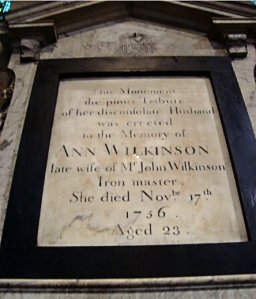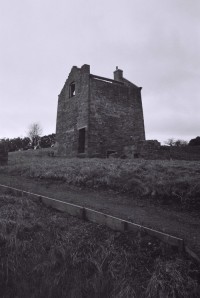https://thefireonthehill.wordpress.com/
A blog about a local area to me. Unfortunately, not updated since 2018. However, still a good source of information on that area and the history of. For example -
It’s nearly impossible to talk about the history of Brymbo without mentioning John Wilkinson at some point. Though there seem to have been coal-pits in the area from mediaeval times, and though previous owners of the Brymbo estate might have tried to make money from minerals (such as Robert Griffith with coal, and Arthur Owen with lead), Wilkinson was the first to make an obvious success of it. It was through the expansion of his holdings, as we have seen, that much of the upper part of the township was turned from common and waste into farmland. Lastly, his bringing together of the particular resources of the locality – ironstone, coal, and limestone from the nearby mountain, along with plenty of fast-flowing water – laid the foundations of an industry that would come to define the area for the best part of two hundred years.
Plenty has been written about Wilkinson already, of course. There has been at least one detailed biography, and Alfred Palmer’s article John Wilkinson and the Old Bersham Iron Works, published in 1897-8 in the Transactions of the Honourable Society of Cymmrodorion, gives a huge amount of detail about both the works at Bersham and his later enterprise at Brymbo. Nevertheless it is probably worth talking about Wilkinson a little, if only because – as I mentioned at the start – he cannot be ignored.

Memorial to Ann Wilkinson ("the pious Tribute of her disconsolate Husband") in Wrexham parish church.
The association of Wilkinson and the Wrexham area goes back for many years before he set up at Brymbo, which was one of his later acquisitions (purchased “about 1793”, according to Palmer). It was Isaac, John’s father – a skilled and clever ironworker, though a chaotic businessman – who took over the lease to Bersham furnace in 1753, while John would soon follow him to act as the works manager. It seems clear, however, that John was eager to gain business independence, and a legacy from his first wife Anne (along with, later, the financial resources of his second wife Mary) helped enable him to achieve this. From a second small ironworks in Shropshire, he shrewdly diversified into arms manufacture at a time when foreign wars brought the potential of large profits.
It was this particular combination of sound commercial sense, energy, total focus, an innovative streak – or at least an ability to judge whose innovations might be worth emulating – and simple good luck that makes Wilkinson an intriguing figure, even at over two hundred years’ distance. He was clearly a man who could (and often did) exasperate his friends, family and colleagues. However there is also something appealing, at times, in the same characteristics. Palmer noted it in his article, writing of a letter sent by Wilkinson to his agent, Hugh Meredith at Minera, that there was “something about this letter which I like, Wilkinson’s honesty and frankness, the friendliness with which he treated his assistants, the trust he reposed in them, are revealed in it”.
Despite this, his relationship with his family seems to have become rather less friendly. There was a breakdown in relations between John and his father, who was to leave Bersham in the 1760s, involving himself in a number of largely unsuccessful iron-founding ventures in South Wales. By the time of Isaac’s death, at an advanced age, in 1784, the quarrel between him and his son had erupted into litigation. A dispute also seems to have arisen between John and his younger brother William, a partner in the Bersham ironworks, that was to have drastic consequences. I will let James Stockdale, as quoted by Alfred Palmer, tell the story at this point:
For some time before the end of last century, John Wilkinson had taken his brother [William] into partnership in all his iron works, but from the very first it was unlikely that two such clever, determined, and most intractable men should long continue friends; accordingly, in a very few years, a quarrel past all reconciliation took place, and then a tooth and nail combat ensued , in its results almost ludicrous. Wm. Wilkinson […] collected […] a great number of men in the town of Wrexham in Wales, and marched with them to the large iron works at Bersham, and there, with sledge hammer and other instruments, began to break up the expensive machinery. On intelligence of this reaching John Wilkinson, he collected a still greater number of men, and followed exactly his brother’s example, so that in a very short time the famous Bersham Iron Works became a great wreck, each brother appropriating to himself as much of the spoil as came within his reach.
The source of the disagreement was, in fact, reckoned to be John Wilkinson’s purchase of the Brymbo Hall estate and his subsequent commencement of an iron works there – all quite independently of his brother and partner William. As we have seen, the potential of the land at Brymbo was already well established, with proven reserves of coal and iron ore, and limestone nearby, not to mention lead mines. When the owners of the Brymbo estate – Jane Wynne, granddaughter of Robert Griffith, and her son-in-law Thomas Assheton-Smith (later a great industrialist in his own right through his development of the Dinorwic slate quarries) – came to sell, it must have been an opportunity Wilkinson could not refuse, even if he had to borrow a substantial sum of money from the Boulton & Watt partnership, clients of his ironworks, to do it.
Soon Wilkinson was raising coal at Brymbo, substantially expanding the number of pits. His engine-house at Penrhos, of course, can still be seen. Later he was to drive a great level, the Level Fawr, under the estate at a depth of 130 yards, opening into the Glascoed valley and draining the coal mines. Some of the coal went initially to feed the furnaces of the lead smelting works he built near Cae-llo on the edge of his estate. He also improved the drainage, and therefore the productivity, of the leadmines nearby at Minera, using steam engine designs pirated from his associates Boulton & Watt (a fact William was quick to reveal once the relationship between them broke down). And after lead, he turned to iron: in 1795 he had a blast furnace built near the Hall, and began smelting the ore raised from the pits nearby: a development that ultimately was to shape the area’s future. After centuries of rural semi-obscurity, it was Wilkinson’s energy that began to form the landscape we see there today.

No comments:
Post a Comment